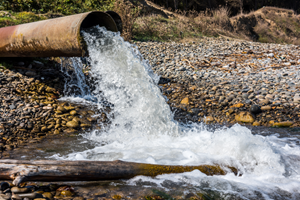Michigan receives low grades for drinking water, stormwater, wastewater infrastructure
(UI) — The Michigan Section of the American Society of Civil Engineers (ASCE) released the 2023 Report Card for Michigan's Infrastructure, with civil engineers grading Michigan’s drinking water (D+), stormwater (D) and wastewater (C).

Michigan policymakers have driven progress in the last five years to improve infrastructure assets by implementing short-term funding solutions to address decades of deferred maintenance, including improved water infrastructure systems through the MI Clean Water Plan.
The state will also benefit from recent federal infrastructure investments included in the Bipartisan Infrastructure Law (BIL), Coronavirus Aid, Relief, and Economic Security (CARES) Act, and American Rescue Plan Act (ARPA). However, Michigan generally lacks sufficient long-term funding mechanisms to ensure all infrastructure sectors reach and sustain a state of good repair.
"Under Governor Whitmer, we have begun to dig our state's infrastructure out of a deep hole, resulting in higher grades, and I remain confident that we will embrace future opportunities to make Michigan more efficient and resilient. I am committed to working across all levels of government to deliver the A+ that Michiganders deserve," said Rep. Haley Stevens (MI11).
Increasingly severe weather events are putting additional strain on legacy systems. There have been seven federal disaster declarations in Michigan related to severe storms in the past 10 years. To address age, deferred maintenance backlogs, and severe weather impacts, nearly all infrastructure sectors in Michigan are being led by asset management programs, which helps agencies and departments best determine when and how to carry out necessary maintenance projects and make the most of limited resources.
“State leaders should be commended for the progress they’ve made addressing Michigan’s aging assets, which had been neglected for far too long,” said Brad Ewart II, P.E., president, ASCE Michigan Section. “Although we’re moving in the right direction, we need to continue to prioritize the built environment to keep Michiganders safe and the economy strong.”
Drinking water (D+) and wastewater (D+)
The state faces potential problems with drinking water systems that are more than 50 years old and some approaching 100 years old, yet less than 1% of pipes are being replaced annually. The state also faces a massive funding gap due to decades of deferred maintenance. Michigan’s water investments are falling short by anywhere from $410 million to $710 million per year. These estimates do not include addressing emerging contaminants such as PFAS, nor lead service line replacements.
Since 2013, Michigan has been making great strides in asset management through their Stormwater, Asset Management & Wastewater (SAW) grant funding and creation of the Michigan Water Asset Management Council (WAMC). However, the Michigan Department of Environment, Great Lakes and Energy (EGLE) estimates $2.71 billion is needed for Michigan’s aging wastewater treatment systems. Michigan has combined sewer areas which are designed to collect everything from domestic sewage to rainwater runoff, to industrial wastewater in the same pipe, which leads to combined sewer overflows (CSOs) when excess rainwater overwhelms the system and allows untreated wastewater to discharge into nearby bodies of water.
Untreated CSO discharges have been reduced from over 10 billion gallons annually between 2016-2018 to less than four billion gallons per year in 2019-2020. Michigan’s Clean Water initiative provided a historic $500 million investment to address large infrastructure issues such as PFAS, undersized sewers, failing septic systems, and SSO/CSO elimination, although long-term funding mechanisms are still needed.
Solutions
The report also includes calls to action to raise the grades, some of which include proactively attacking workforce development challenges. The infrastructure workforce makes improvement possible, and most employers are now struggling to retain, hire, or train staff. Government leaders, the private sector, and educational institutions should coordinate efforts so Michigan can maximize the positive benefits of recent federal and state investment.
Solutions to raise the grades also involve focused planning and design on resilience and reliability. Michigan’s energy grid was unreliable in recent storm events and stormwater infrastructure is not sufficient to endure increasingly unpredictable and high-magnitude threats. Decision-makers should advance upgrades to infrastructure systems which stay operational during adverse events, using redundancy and other methods to withstand the worst expected environmental conditions.
Related News
From Archive

- Glenfarne Alaska LNG targets late-2026 construction start for 807-mile pipeline project
- U.S. water reuse boom to fuel $47 billion in infrastructure spending through 2035
- $2.3 billion approved to construct 236-mile Texas-to-Gulf gas pipeline
- Major water pipe break in Puerto Rico hits over 165,000 customers
- Potomac River Tunnel project enters construction phase beneath Washington, D.C.
- Pennsylvania American Water launches interactive map to identify, replace lead water service lines
- Trump's tariffs drive $33 million cost increase for Cincinnati sewer project
- Utah city launches historic $70 million tunnel project using box jacking under active rail line
- Tulsa residents warned after sewer lines damaged by boring work
- Fatal trench collapse halts sewer construction in Massachusetts; two workers hospitalized



Comments